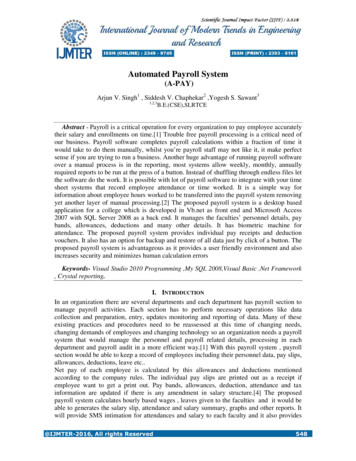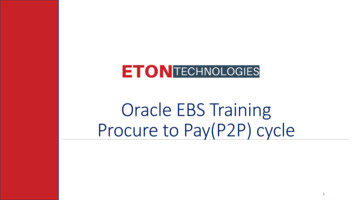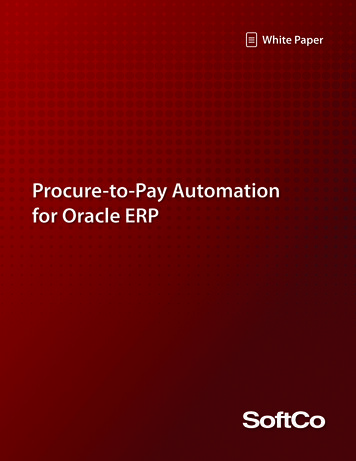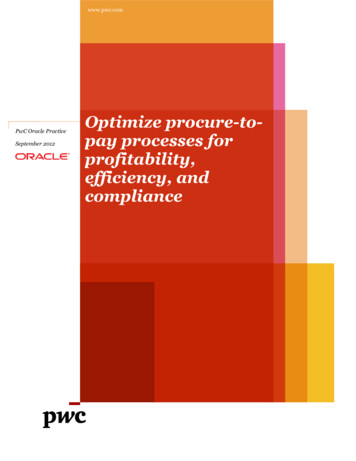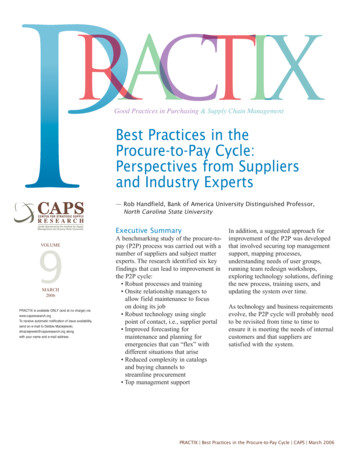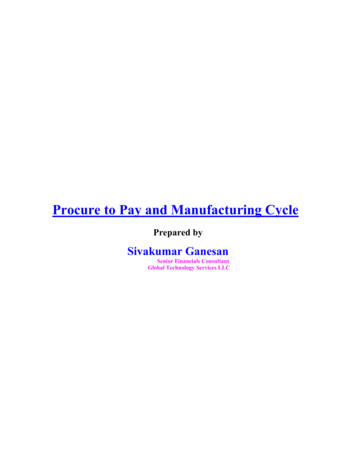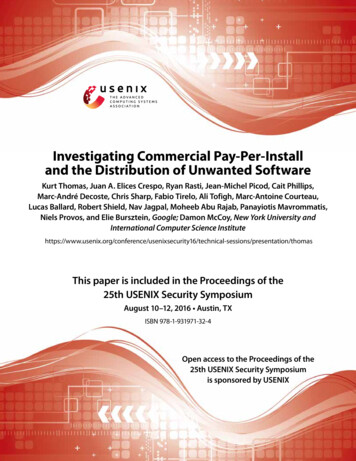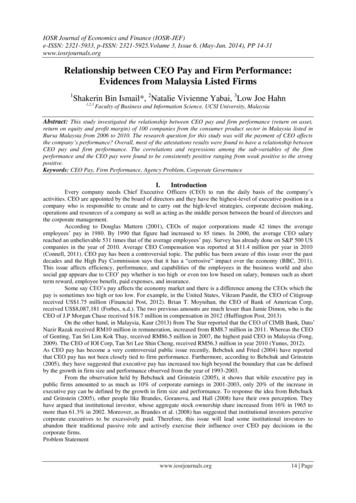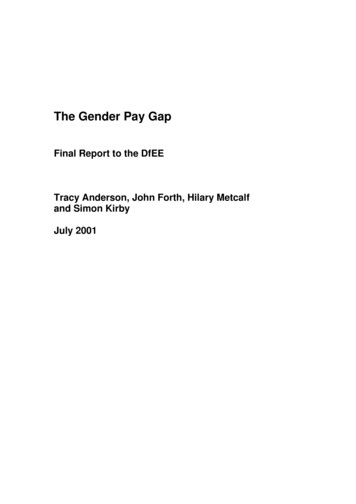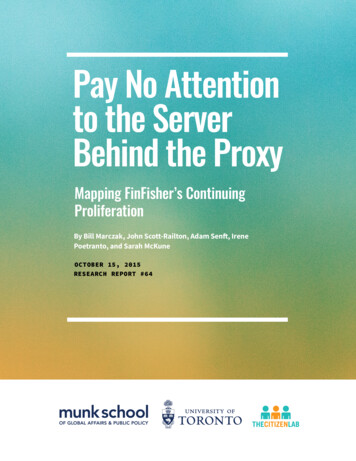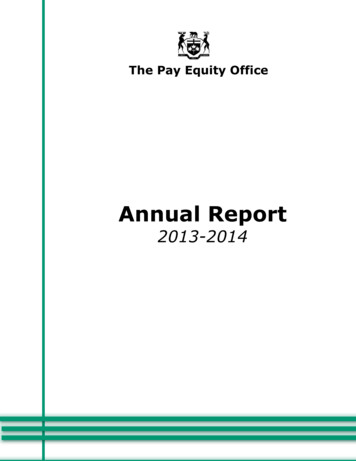
Transcription
The Pay Equity OfficeAnnual Report2013-2014
Pay Equity Office Annual Report 2013-2014This page has been intentionally left blank. 2 Annual Report 2013/14
Pay Equity Office Annual Report 2013-2014Table of ContentsCOMMISSIONER’S MESSAGE .5ONTARIO’S PAY EQUITY ACT .6ABOUT THE PAY EQUITY OFFICE .7VISION . 7MISSION . 7LEGAL MANDATE. 7VALUES . 7OVERVIEW AND KEY ACHIEVEMENTS .8OUTREACH AND EDUCATION . 8PAY EQUITY INVESTIGATIONS AND MONITORING . 9ADVANCING GENDER WAGE GAP AND PAY EQUITY. 11PERFORMANCE MEASURES . 12PAY EQUITY OFFICE ORGANIZATION . 13STAFF . 13UNIT DESCRIPTIONS . 14COMMISSIONER’S OFFICE . 14DIRECTOR’S OFFICE. 14REVIEW SERVICES . 14RESEARCH, EDUCATION AND OUTREACH . 14CORPORATE AND LEGAL SERVICES . 14FINANCIAL PERFORMANCE 2013-2014 . 15ACCOUNTABILITY STATEMENT . 16APPENDIX 1 – CASELOAD STATISTICS . 17Annual Report 2013/14 3
Pay Equity Office Annual Report 2013-2014This page has been intentionally left blank. 4 Annual Report 2013/14
Pay Equity Office Annual Report 2013-2014Commissioner’s MessageMuch has been written about the gender wage gap in the 25 years since thePay Equity Act was enacted. In 1988 it was clear both from an economic andhuman rights perspective that significant intervention would be necessary toaddress the many causes of the gender wage gap. While pay equity was animportant key mechanism, it was recognized that it alone would not narrow thegap nor effect the necessary culture change required to fully recognize thevalue of women’s work. In the intervening years, progress on the broaderissue of narrowing the gender wage gap and influencing culture change hasbeen slow; there is a renewed recognition that a more integrated and systemicapproach involving government,labour,business and working women isneeded.Reflecting on 25 years of operation, the Pay Equity Commission (PEC) has had many successes ineducating the public and enforcing the Act, raising the wages for hundreds and thousands of workingwomen. These successes have been well documented in literature and in previous Annual Reports.For our part, in 2013-14, the Office published a mini-kit for small business, available on our website, inrecognition of the fact that small to medium businesses form the majority of Ontario enterprises. Ouroutreach partnerships with the Ministries of Labour and Ministry of Economic Development, Trade andEmployment (METDE), and with Human Resources Professional Association (HRPA), continue to increaseour ability to expand our contact with the business community and increase awareness of the obligationsrequired to comply with the Act. For the first time, Pay Equity Office (PEO) was successful in partneringwith the Toronto Board of Trade to mark International Women’s Day by hosting a “Toronto Board of TradeEvent”.We also contributed to the broader policy dialogue on issues affecting women and work. In October of2013, our Office made submissions to the Ontario Securities Commission in its public consultation arounddisclosure requirements of gender related initiatives in publicly traded companies (comply or explain). Atthe same time, the PEO made submissions to Ministry of Labour (MOL) during its consultation processaround minimum wage. In our view both of these initiatives are important contributions that, ifimplemented, will work towards ensuring women’s economic advancement in Ontario.During this fiscal period, the Office undertook an extensive review of its vision, values and missionstatement in recognition of the need to adapt to changing priorities of both government and the public. Thisexercise informed the crafting of three strategic objectives that will form the basis for the next three yearplanning cycle.As always, I take this opportunity to thank our staff for their continued dedication to pay equity and for theirwork in educating businesses about the merits of having compensation practices that value the work andcontribution of all employees, regardless of gender.Respectfully SubmittedEmanuela HeyninckAnnual Report 2013/14 5
Pay Equity Office Annual Report 2013-2014Ontario’s Pay Equity ActAccording to Statistics Canada, the 2011 gender wage gap in Ontario for full-time, full-year employment is26%. Studies show that nearly a third of this gap could be attributed to systemic discrimination in theworkplace and can be manifested throughout an organization: from the hiring process, the organizationalculture, assignment of work, through to how specific jobs are paid. These forms of discrimination areaddressed by a variety of laws. The purpose of the Pay Equity Act is to redress systemic genderdiscrimination in the compensation of employees in female job classes. All public sector employers and allprivate sector employers with ten or more employees are required to have compensation practices thatprovide for pay equity.Achieving Pay EquityThe Act sets out the criteria to be applied by employers to identify systemic gender discrimination incompensation and the means by which it is to be corrected.To meet the minimum requirements and to show that pay equity has been achieved, all employers coveredby the Act are required to undertake the following at each of the employer’s establishments:12345Note: Determine job classes, including identifying the gender of the job class and job rate; Determine the value of job classes based on factors of skill, effort, responsibility and workingconditions; Conduct comparisons for all female job classes using the job-to-job, proportional value orproxy method of comparison (proxy is for public sector only and of limited application); Adjust the wages of underpaid female job classes so that they are paid at least as much orequal to a comparable male job class or classes within the establishment; Maintain pay equity for female job classes to ensure that new pay equity gaps are notcreated or re-emerge.* The proxy method of comparison contained in Part II of the Act was, repealed in 1996 and restored bycourt order in 1997. The Pay Equity Office continues to enforce the proxy provisions. 6 Annual Report 2013/14
Pay Equity Office Annual Report 2013-2014About the Pay Equity OfficeIn 2013-14, the Pay Equity Office undertook arevision of its vision, mission and values to reflectits current strategic direction.VisionAdvance gender economic equality in Ontario.MissionThe Commission promotes gender economicequality by enforcing pay equity rights andobligations through effective case and complaintmanagement; understanding gender wage gapthrough research; and promoting awareness toadvance economic equality for Ontario’s workingwomen.Legal MandateThe Pay Equity Commission was established bysection 27 of the Pay Equity Act, 1987, S.O.1987.c.34 (the Act) and is continued bysubsection 27(1) of the Act, R.S.O, 1990, c.P.7as amended (the Act). The Commission consistsof two separate and independent parts: the PayEquity Hearings Tribunal (PEHT), and the PayEquity Office.The Commissioner is the head of the PEO andthe Chief Administrative Officer (CAO) of thePEC, appointed by the LieutenantGovernor in Council on therecommendation of the Minister. TheChair of the PEHT is responsible for thePEHT’s administration.The Minister of Labour is accountable tothe government for the PEC and isresponsible for representing the PEC inCabinet and its Committees, in theLegislative Assembly and before Committees ofthe Legislature. The Minister is accountable tothe Legislature for the PEC’s fulfillment of itsmandate and compliance with governmentadministrative policies. The Minister is alsoresponsible for the review and approval of thePEC’s Business Plan and Annual Report, and forsubmitting them to Management Board ofCabinet.ValuesFAIRNESS - We demonstrate integrity byproviding equitable and impartial enforcementactions.ACCOUNTABILITY - We accept responsibilityfor our activities and disclose the results in atransparent manner.SERVICE EXCELLENCE - We strive to provideoutstanding and responsive service.IMPACT - We influence, educate, and enforce toachieve and maintain pay equity in Ontarioworkplaces.CONNECT- We connect and advance women’scompensation issues by building effectivepartnerships with diverse stakeholders andcommunities.To advance gender economicequality in OntarioAnnual Report 2013/14 7
Pay Equity Office Annual Report 2013-2014Overview and Key AchievementsThe Pay Equity Office achieves its mandatethrough: Conducting education and outreach; Investigating and resolving complaintsthrough alternative dispute resolutionmethods, or issuing Orders forcompliance; Referring Orders to the Pay EquityHearings Tribunal (the Tribunal) forenforcement; Monitoring establishments forcompliance with the provisions of theAct; Researching and disseminatinginformation about pay equity andOntario’s gender wage gaps to thepublic and workplace parties; Preparing reports and recommendationsto the Minister about pay equity andrelated matters.Outreach and EducationCommunicating the purpose and obligations ofthe Pay Equity Act is a cornerstone function ofthe Pay Equity Office. The PEO utilizes variouschannels of communication to inform toemployers, bargaining agents, employees andinterested parties on the implementation andmaintenance of pay equity.The PEO has a self-serve website that hasguides, tools and 24/7 e-learning modules toprovide site visitors with the information that theyneed. This year, our 15 e-learning modules werere-vamped, a tool for small business employerswas released to support job evaluation and payequity analysis and our case study (Space Toycompany case study) was refreshed andupdated. PEO also partnered with ServiceOntario to add information on pay equity 8 Annual Report 2013/14legislation and requirements to the “ONe-Source”website. ONe-Source provides employers withdirect access to information on governmentservices at all levels and support in operating andgrowing a business or not-for-profit organization.The PEO continues to evaluate its web resourcesto ensure that information remains relevant andreviews other government sites for potentialcross-links.In addition to the availability of the website, thePEO conducts real-time training throughwebinars and seminars. This year twenty-onewebinars were delivered to over 440 participants.Webinars are offered in five key areas andenables two-way interaction on critical topics.The PEO also conducted twenty-two speakingengagements with private sector employers, highschools and universities and at human resourcesprofessionals’ regional association meetings.The PEO prioritizes its outreach opportunities tomaximize its reach to employers and the use ofpartnerships enables the PEO to leverage limitedresources. In 2013/14, the PEO partnered withseveral business associations to provideeducation materials and conduct outreach withemployers at small business forums and annualbusiness association meetings such as theOBEA (Ontario Business Educators’Association), the SOHO SME Expo (Small andMedium Size Enterprise), Enterprise TorontoSmall Business Forum, BGSY (Business,Government Services and You) as well as theCanadian Restaurant and FoodservicesAssociation conference. At the HRPA (HumanResources Professionals Association) nationalconference, a workshop was delivered and ourvendor booth reached over 700 human resourcesprofessionals.As part of a strategy to reach senior executives,the PEO partnered with the Toronto Region
Pay Equity Office Annual Report 2013-2014Board of Trade, hosting a panel discussion on“Inspiring Change – Taking Action on GenderEquality” with over 50 attendees from academia,private sector, non-profit and various ministries inattendance.for reports on both the service industrymonitoring program and the wage gap program.Reports on these initiatives will be available in14/15.New CasesWithin government, the PEO, working with theMinistry of Labour, contributed educationalmaterial to the Ministry of Citizenship for theirNewcomer initiative -- this material will beprovided to newly arrived immigrants viabrochures and presentations to inform themabout all aspects of working in Ontario. The PEOcontinues to leverage service delivery optionsthroughout government.The PEO continues to deliver general informationto the public through our telephone line and emailbox. This year, we received over 1100 inquiriesthat are responded to, in accordance with OntarioPublic Service Common Service Standards.Pay Equity Investigations and MonitoringReview Officers investigate complaints allegingcontraventions of the Act and assist theworkplace parties in attempting to settle theissues which can arise during the implementationand achievement of pay equity. This approach isconsistent with the intent of the Act that the payequity process be “self-managed”.In cases where Review Officers are unable toeffect a settlement between the workplaceparties, Review Officers will issue Orders. Anyparty affected by a Review Officer’s decision mayrequest a hearing before the Tribunal. ReviewOfficers may also refer an Order to the Tribunalfor enforcement where a party fails to complywith the provisions of the Order within theprescribed timeframes.This past year, caseload priorities were focussedon complaints, older files and completion of thewage gap program monitoring files. Closure ofthese files enabled the office to analyze case filesIn 2013-2014, the Office received 91 complaintapplications and opened 61 monitoring cases.Sixty-nine percent of the complaint applicationswere from unions and/or their members and 27%were from unrepresented parties.Cases ResolvedThe PEO closed 219 case files in 2013/14. 193cases were resolved with the involvement of aReview Officer. Of these 1931 cases, 1732 or90% of cases achieved compliance without anOrder, were found to have no contraventions ofthe Pay Equity Act, or were settled.In the instance where there is no resolution, aReview Officer can “order” an Employer tocomply with the Act. This year, approximately 9%or 20 of the 219 closed cases were OrderedCases, impacting 14 out of 180 workplaces. Thisrepresents an increase of ordered cases from theprevious year—indicating decreasing workplacecooperation.When an Employer does not comply with therequirements of an Order, the Pay Equity Officecan refer the matter to the Pay Equity HearingsTribunal. Out of 20 ordered cases noted above,three were referred to the Tribunal (PEHT). Theoutcomes of these matters are pending.1219 cases closed minus 26 cases withdrawn equals 193cases.2173 cases equals 103 complied without order plus 60Notices of Decision and 10 Settled cases.Annual Report 2013/14 9
Pay Equity Office Annual Report 2013-2014Caseload PerformancePreliminary data analysis of this pilot programindicate that wage gaps consistently persist inthe province, supporting the need for continuedefforts in raising awareness regarding employers’obligations to ensure their compensationpractices are free from gender bias.In 2012, the PEO set out a target goal of caseresolution within 24 months. Through focussedefforts on aging files, 64% of complaint caseswere resolved in less than 24 months, 15%resolved in 24-36 months and 21% in over 36months.In terms of program effectiveness, 1780 Ontarioworkers received adjustments from theiremployers, totalling nearly 3.6 million in 2013-14compared with 3.3 million inadjustments in 2012-13.Wage Gap Pilot projectA forthcoming monitoring program on pay equitycompliance for firms with an apparent wage gapwill validate whether review tools (used by thePEO) can identify pay equity gaps.1780 Ontario workersMonitoringProgram:Service IndustryThe ServiceThe 2011 Wage Gap Pilotreceived adjustments from their IndustryProgram was launched toMonitoringdetermine if wage gaps persistProgram wasemployers, totaling nearlyin the compensation of menalso concludedand women in Ontariothis past fiscalworkplaces. Initial Reviewyear. Under thisOfficers analyzedprogram, thecompensation data provided byPay Equityemployers in Ontario andOffice assesseddetermined the presence of anythe current stateapparent gender wage gaps.of pay equity knowledge and compliance, andproactively promoted awareness of the PayThis past year, all outstanding wage gap fileEquity Act in the hotel/ motel, retail/wholesale,reviews (158) were completed and overalland food/beverage sectors.findings collated and analyzed. A final samplesize of 351 employers compensation data wasOver the course of the program, 4,000 employersanalyzed. Fifty-four precent of these were foundfrom across the province were contacted. Filesto have an apparent wage gap based on reviewswere opened in annual batches beginning inof the compensation data provided.February 2007, and the last file was opened onSeptember 15, 2010. Only 42 Service IndustryAs a collective sample, the classic wage gapMonitoring Program files (1%) remained open ascalculation, arrived at by calculating the ratio ofof March 31st, 2014. The Office closed 93% ofthe average pay for women over the average payfiles within the first five years of the program. Thefor men yielded a wage gap of 13%. This ismajority of files were opened in the second fiscalconsistent with the earnings ratio in 2010 for fullyear and the third fiscal year of the programand part-time workers which was 86%, yieldi
approach involving government,labour,business and working women is needed. Reflecting on 25 years of operation, the Pay Equity Commission (PEC) has had many successes in educating the public and enforcing the Act, raising the wages for hundreds and thousands of working women.
